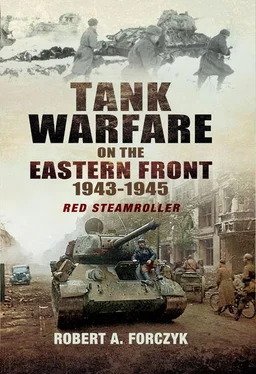Nevertheless, von Manstein’s forces continued to slowly advance, but Hausser needed to shift his axis of attack northward, instead of northeast to Prokhorovka. Soviet mines and anti-tank strength sapped Hausser’s strength with each kilometre gained; on 9 July, Das Reich had 18 tanks knocked out making a 3km advance. Although most damaged tanks could be repaired, the number of operational tanks was quickly dwindling. {103} For their part, both Stalin and the Stavka were increasingly concerned about Vatutin’s inability to completely halt von Manstein’s advance. The Stavka had already directed Rotmistrov’s 5 GTA and other elements of the Steppe Front to begin move toward assembly areas near Prokhorovka. On the morning of 7 July, Rotmistrov’s tank army began moving westward and in three days the bulk of his forces had moved 350–400km and was reorganizing for combat. A total of 227 tanks and self-propelled guns, a total of 31.5 per cent of Rotmistrov’s armour, fell out on the march, but 101 of these were repaired within 48 hours or less. {104} The movement of Rotmistrov’s 5 GTA on its own tracks over such a distance was an amazing demonstration of the Red Army’s growing operational mobility and the basic mechanical soundness of its armoured vehicles. In contrast, the German Panthers and Tigers had much less operational mobility and reliability and could not move so far and so fast without suffering crippling mechanical casualties.
On 10 July, Totenkopf ’s Panzergrenadiers managed to establish a small bridgehead over the Psel near the hamlet of Kliuchi, at the cost of 374 casualties. {105} The river was only 30 metres wide, but the riverbanks were very marshy, so a 60-ton pontoon bridge would be required to get Tigers across. Once Totenkopf ’s armour crossed into the bridgehead, Hausser expected to use this as a springboard to push northward and outflank Soviet defences at Prokhorovka. However, Hausser’s II.SS-Panzerkorps stopped 8km short of Prokhorovka, since its right flank was exposed. The slow progress of Breith’s III. Panzerkorps acted as a brake upon the progress of the Waffen-SS and the large gap between the two corps was a constant distraction during Zitadelle . Hoth and Kempf also found that they did not have adequate infantry to hold ground that had been captured, which forced them to use their limited number of Panzergrenadiers screening flanks instead of supporting the advanced toward Kursk. By 11 July, the German advance was slowing due to casualties and Soviet resistance, but the Stavka was increasingly concerned that nothing so far had actually halted the panzers. The decision to commit Rotmistrov’s 5GTA from Steppe Front to smash Hausser’s II.SS-Panzerkorps was intended to halt any further German advances.
Meanwhile, the Panthers in XXXXVIII Panzerkorps had not enjoyed much success in the drive toward Dubrova. By the second day of Zitadelle , von Lauchert only had about 70 of his original 204 Panthers still operational and his Panzer-Regiment 39 was wandering around lost. Strachwitz’s Panzer-Regiment had pulled out of Cherkasskoye around 1000 hours, without providing any tactical instructions to the Panthers. Von Lauchert apparently missed the order to shift the axis of attack from due north to the Pena River instead due east toward Dubrova, so he advanced hoping to find Strachwitz’s Kampfgruppe. Krivoshein’s 3 MC had already emplaced the T-34s of the 14th and 16th Tank Regiments near Alekseyevka; the Soviet tanks were in hull-down positions behind an anti-tank ditch and minefield, with infantry and anti-tank guns in support. Strachwitz’s panzers moved through the flat, grassy steppe and bumped unexpectedly into the anti-tank ditch and came under heavy fire. Meanwhile, von Lauchert decided to ‘move to the sound of the guns’, but had no idea of the situation. He put Major Gerhard Tebbe’s Panzer-Abteilung 52 in the lead, with the first company in Panzerkeil (armoured wedge) formation, but the rest of the regiment in double columns. Without reconnaissance or support, the Panthers blundered straight into a minefield and came under heavy fire. Tebbe was an experienced combat veteran but he froze in the kill zone, allowing T-34s from the 14th Tank Regiment to engage the columns of Panthers with flank shots from 1,000–1,200 metres. The Panther’s side armour was only 40mm on the hull and 45mm on the turret, which was insufficient to stop the Soviet 76.2mm BR-350A APHE round at that range (it could penetrate 60mm) and several Panthers were destroyed. Tebbe lost control and Oberleutnant Erdmann Gabriel, commander of the 8.Kompanie, took charge and ordered the Panthers to engage the hull-down T-34s. When the Panther’s long 7.5cm KwK 42/L70 gun opened fire with their high-velocity Panzergranate 39/42 AP rounds, the Soviet tankers were stunned by the destruction inflicted and decided to break off the action. At least 19 Panthers were knocked out or disabled in their first real tank battle, in return for inflicting only a few casualties on their opponents. Von Lauchert finally caught up with Strachwitz’s Panzers. Major Tebbe was relieved of command and replaced by Hauptmann Georg Baumunk, another experienced tanker. [27]
On 7 July, Strachwitz resumed the offensive toward Dubrova, but ran into another hornet’s nest near Syrtsevo, where 20 T-34s from the 16th Tank Regiment and anti-tank guns were dug in behind mines. Apparently there was little reconnaissance or pionier support for this advance – another indicator that the German combined arms team was no longer fully functional – and Strachwitz ran right into mines placed in a ravine crossing site. More Panthers were immobilized, then shot up with flank shots. Oberleutnant Gabriel’s Panther was hit:
I was severely hit by an anti-tank round that penetrated the munitions chamber at the left side, causing the later to explode immediately… I tore off the smoldering headset and microphone with my severely burnt hands, which already had the fingernails popped off. By then the gunner was pushing out from below, but I had to push his head so as to get out of the turret myself. This all happened very fast… After me, the gunner was still able to rescue himself. He had suffered burns, mainly on his face. {106}
Eventually, von Lauchert and Baumunk were able to organize the remaining Panthers to lay down suppressive fired on the entrenched tanks and the T-34s were either picked off by the long 7.5cm guns or retreated. Strachwitz claimed that his Kampfgruppe had destroyed 62 enemy tanks, but this was likely exaggerated. However, 27 Panthers were knocked out and Walter Rahn from the Panzer-Abteilung 52 later noted that, ‘we felt the day was a defeat and long thereafter referred to the Panther cemetery at Dubrova.’ On 8 July, the XXXXVIII Panzerkorps made another major push past Dubrova, trying to advance along the road to Oboyan, but engaged in a fierce tank melee with Polkovnik Mikhail T. Leonov’s 112th Tank Brigade and Polkovnik Nikolai V. Morgunov’s 200th Tank Brigade, both from Getman’s 6 TC, near Verkhopen’ye. However, only 10–20 Panthers were still operational and it was Major Peter Franz’s StuG-IIIs from Sturmgeschütz-Abteilung Großdeutschland that won these tactical engagements for the Germans. Stung by the loss of about 50 tanks, Getman’s 6 TC pulled back a bit and was reinforced with a fresh rifle division and the 29th Anti-Tank Brigade (as well as tank replacements), in order to block the Oboyan River. {107} During the period 9–11 July, the XXXXVIII Panzerkorps made only minor advances and the last operational Panthers fought a number of platoon and company-size actions against Getman’s 6 TC, but failed to break through. Another 13 Panthers were lost in action against about 50 Soviet tanks, but the remaining Panthers were crippled by mechanical defects. Oberst Strachwitz was also a casualty, when he suffered a severe injury from breach recoil on 10 July. [28]
Читать дальше








![John Stieber - Against the Odds - Survival on the Russian Front 1944-1945 [2nd Edition]](/books/405234/john-stieber-against-the-odds-survival-on-the-russian-front-1944-1945-2nd-edition-thumb.webp)



